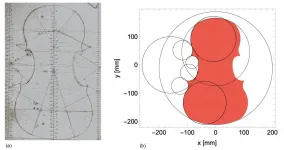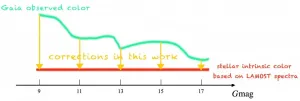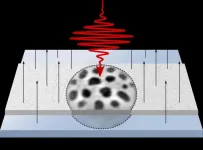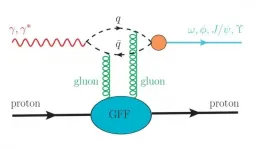Violinmaking meets artificial intelligence
The next generation of violins in a study published on Nature Scientific Reports by Politecnico di Milano
2021-05-12
(Press-News.org) How to predict the sound produced by a tonewood block once carved into the shape of a violin plate? What is the best shape for the best sound? Artificial Intelligence offer answers to these questions.
These are the conclusions that researchers of the Musical Acoustics Lab of Politecnico di Milano presented in a study that was recently published in Scientific Reports.
In the article "A Data-Driven Approach to Violinmaking" the Chilean physicist and luthier Sebastian Gonzalez (post-doc researcher) and the professional mandolin player Davide Salvi (PhD student) show how a simple and effective neural network is able to predict the vibrational be-havior of violin plates. This prediction is obtained from a limited set of geometric and mechanical parameters of the plate.
The ability to predict the sound of a violin design, can truly be a game changer for violin makers, as not only will it help them do better than the "grand masters", but it will also help them explore the potential of new designs and materials. This research allowed us to take the first steps in this direction, showing how Artificial Intelligence, physical simulation and craftsmanship can all join forces to shed light on the art of violin making.
Violins are extremely complex objects, and their geometry is defined by their outline, arching on the horizontal and vertical sections. The inspira-tion of this study came from a historical drawing on display at the "Museo del Violino" in Cremona. Politecnico di Milano researchers developed a model that describes the violin's outline as the conjunction of arcs of nine circles. Thanks to this representation and an effi-cient model of the curvature of the plate, based on the renowned "Messi-ah" violin by Stradivarius, researchers were able to draw a violin plate as a function of 35 parameters.
By randomly changing such parameters, such as radii and center position of the circles, arching, thickness, mechanical characteristics of the wood, etc., they built a dataset of violins, which includes shapes that are very similar to those used in violin making, but also designs that had never been seen before. Such shapes constituted the input for the neural network.
Advanced tools for the modeling of vibrations were used for characterizing the acoustic behavior of each violin in the dataset.
The next step was to understand if a simple neural network would be able to predict the acoustic behavior of a violin plate, starting from its parame-ters. The answer turned out to be positive, with an accuracy that came close to 98%, exceeding any expectations.
This work offers an innovative and promising tool in the hands of Cremona violin makers and, in perspective, of the international community. By using a neural network, it will enable luthiers to predict how a tone-wood block will "sound" once carved into a plate. But it can also be used to design two violins with matching acoustic behavior even if built with different wood. In the future this research will allow us to select the best wood to be used for a particular violin, something that today is still based on purely aesthetic considerations.
The full-text version of the article is available here: https://www.nature.com/articles/s41598-021-88931-z
INFORMATION:
[Attachments] See images for this press release:

ELSE PRESS RELEASES FROM THIS DATE:
2021-05-12
The Large Sky Area Multi-Object Fiber Spectroscopic Telescope (LAMOST) has helped Gaia achieve millimagnitude (mmag) precision in photometry, according to a study led by researchers from National Astronomical Observatories of Chinese Academy of Sciences (NAOC) and Beijing Normal University (BNU).
Their study was published in The Astrophysical Journal.
If you look at the sky on a clear, starry night, you may notice that Aldebran is relatively red and Rigel is blue. Why? The answer stems from their intrinsic physical properties. Precisely measuring magnitudes ...
2021-05-12
The polar vortex is a large area of upper-atmosphere cyclonic air circulation surrounding both poles. It is bounded by the polar jet stream and its associated cold air is usually confined to the polar regions. Within the Antarctic circle, and southern polar vortex, ozone quantities are the lowest, globally. A research published in Advances in Atmospheric Sciences, led by Dr. LUO Yuhan, corresponding author and Associate Professor at the Hefei Institutes of Physical Science (HFIPS), suggests that the polar vortex plays a key role in Antarctic stratospheric ozone depletion.
"The atmosphere over Antarctica is controlled by a strong ...
2021-05-12
May 1, 2021 - Rheumatologists in Hong Kong joined hands to develop a set of consensus statements on COVID-19 vaccination for local adult patients with autoimmune rheumatic diseases. These timely statements would serve to be a guide for rheumatologists, other specialists, family physicians, specialty nurses, and the public regarding COVID-19 vaccination for patients with rheumatic diseases.
Vaccination against SAR-CoV-2 is a new campaign and a high immunization rate is believed to be the key to end the pandemic. Currently, there are two COVID-19 vaccines available in Hong Kong--the inactivated virus vaccine CoronaVac® ...
2021-05-12
Parks played an important role for people seeking respite from the toll of social isolation during the pandemic, and according to new research from Drexel University, they did so without increasing the spread of COVID-19. The study looked at how people used 22 parks in Philadelphia and New York during the height of the pandemic and it found no strong correlation between park use and the number of confirmed cases in surrounding neighborhoods.
Published in the Journal of Extreme Events, Drexel's study "Urban Park Usage During the COVID-19 Pandemic" surveyed park visitors over a three-month period from May to July 2020 at small and mid-size parks in New York and Philadelphia. And it compared park usage numbers ...
2021-05-12
An essential preliminary to building and construction or resource extraction is studying the geological structure of the site. One of steps of this process is geophysical investigation. This provides a continuous overview of the geological horizons rather than just data on points: boreholes. The standard methods of geophysics help successfully solve this problem in comparatively simple conditions. Yet the classical direct current methods may lead to serious inaccuracy if we have to investigate geologically complex structures with thin layers of sandy and clayey soils.
Among the most popular methods ...
2021-05-12
Leipzig/Jena/Ilmenau. Mobile apps like Flora Incognita that allow automated identification of wild plants cannot only identify plant species, but also uncover large scale ecological patterns. These patterns are surprisingly similar to the ones derived from long-term inventory data of the German flora, even though they have been acquired over much shorter time periods and are influenced by user behaviour. This opens up new perspectives for rapid detection of biodiversity changes. These are the key results of a study led by a team of researchers from Central Germany, which has recently been published in Ecography.
With the help of Artificial Intelligence, plant species ...
2021-05-12
The gopher tortoise (Gopherus polyphemus) is declining because of habitat loss and fragmentation, human interaction including collisions with vehicles, predation by domestic animals, and disease. These long-lived reptiles are found throughout Florida and are affected by various diseases including upper respiratory tract disease. A number of pathogens such as Mycoplasma spp., Herpesvirus, and Ranavirus are known to cause upper respiratory tract disease in gopher tortoises. Chronic disease resulting from these pathogens can lead to reduced reproduction, abnormal growth and development, increased susceptibility to secondary ...
2021-05-12
Lysophospholipids are phospholipids that have just one fatty acid chain, and in recent years, the role of lysophospholipids in physiology and pathophysiology has attracted attention. Lysophosphatidylethanolamine (LPE) is a type of lysophospholipid that are reportedly present in the brain that consist of many species with different fatty acid chain lengths and degrees of unsaturation. The latest studies in animal models have reported elevated levels of LPE in the brain after traumatic brain injury and cerebral ischemia. Fluctuations in LPE concentration have also been reported in the plasma of patients with major depression and Alzheimer's disease. Although these reports suggest the involvement of LPE in brain function, the role of LPE in the brain has remained unclear.
Therefore, ...
2021-05-12
Smaller, faster, more energy-efficient: future requirements to computing and data storage are hard to fulfill and alternative concepts are continuously explored. Small magnetic textures, so-called skyrmions, may become an ingredient in novel memory and logic devices. In order to be considered for technological application, however, fast and energy-efficient control of these nanometer-sized skyrmions is required.
Magnetic skyrmions are particle-like magnetization patches that form as very small swirls in an otherwise uniformly magnetized material. In particular ferromagnetic thin films, skyrmions are stable at room temperature, with diameters down to the ten-nanometer range. It is known that skyrmions can be created and moved by short pulses of electric current. Only recently it was discovered ...
2021-05-12
Researchers have recently extracted the proton mass radius from the experimental data.
A research group at the Institute of Modern Physics (IMP) of the Chinese Academy of Sciences (CAS) presented an analysis of the proton mass radius in Physical Review D on May 11. The proton mass radius is determined to be 0.67 ± 0.03 femtometers, which is obviously smaller than the charge radius of the proton.
In the Standard Model, the proton is a composite particle made of quarks and gluons and it has a non-zero size. The radius of the proton is a global and fundamental property of the proton. It is related to the color confinement radius -- a property governed by quantum chromodynamics (QCD).
The radius of the proton is approximately 100,000 times smaller ...
LAST 30 PRESS RELEASES:
[Press-News.org] Violinmaking meets artificial intelligence
The next generation of violins in a study published on Nature Scientific Reports by Politecnico di Milano







